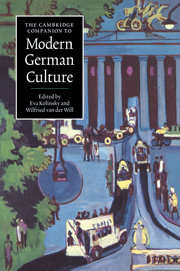Book contents
- Frontmatter
- In search of German culture: an introduction
- 1 The citizen and the state in modern Germany
- 2 German national identity
- 3 Elites and class structure
- 4 Jews in German society
- 5 Non-German minorities, women and the emergence of civil society
- 6 Critiques of culture
- 7 The functions of 'Volkskultur', mass culture and alternative culture
- 8 The development of German prose fiction
- 9 Modern German poetry
- 10 German drama, theatre and dance
- 11 Music in modern German culture
- 12 Modern German art
- 13 Modern German architecture
- 14 German cinema
- 15 The media of mass communication: the press, radio and television
- Index
12 - Modern German art
Published online by Cambridge University Press: 28 May 2006
- Frontmatter
- In search of German culture: an introduction
- 1 The citizen and the state in modern Germany
- 2 German national identity
- 3 Elites and class structure
- 4 Jews in German society
- 5 Non-German minorities, women and the emergence of civil society
- 6 Critiques of culture
- 7 The functions of 'Volkskultur', mass culture and alternative culture
- 8 The development of German prose fiction
- 9 Modern German poetry
- 10 German drama, theatre and dance
- 11 Music in modern German culture
- 12 Modern German art
- 13 Modern German architecture
- 14 German cinema
- 15 The media of mass communication: the press, radio and television
- Index
Summary
Introductory background
The course of modern art in Germany has followed a path significantly different from that of its neighbouring European cultures. The artistic achievements of its Renaissance period, notably those of Albrecht Dürer, Hans Holbein, Matthias Grünewald and Hans Baldung Grien, were to remain unequalled in the wake of the Lutheran Reformation, the Peasants' War and the Thirty Years War which worked to weaken both the economy and the morale of the country. The political fragmentation of Germany made cultural communication difficult. In the early nineteenth century the lack of a metropolis and a 'grand tradition' led painters and sculptors to look for enrichment through the adaptation of philosophical, religious and poetic issues and sensibilities. Artists such as Phillip Otto Runge and Caspar David Friedrich, the Nazarenes or the Neo-Romantics Feuerbach and Bocklin were deeply influenced by religious and philosophical treatises and tried to create pictorial expression for them. It is here that we can identify the roots of what is becoming increasingly acknowledged as one of the main hallmarks of German modernism, namely, the unique interconnections between ideas, events and artistic representations within this school of painting and sculpture.
- Type
- Chapter
- Information
- The Cambridge Companion to Modern German Culture , pp. 256 - 281Publisher: Cambridge University PressPrint publication year: 1999



